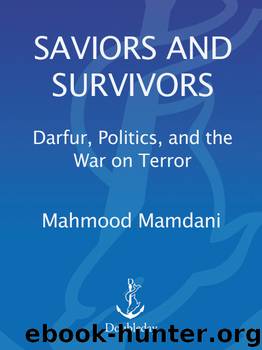Saviors and Survivors by Mahmood Mamdani

Author:Mahmood Mamdani [Mamdani, Mahmood]
Language: eng
Format: epub
ISBN: 978-0-307-59118-0
Publisher: Crown/Archetype
Published: 2010-05-25T04:00:00+00:00
Islamism
There was more than just a passing resemblance between the Bashir-led Islamist coup of 1989 and the earlier Communist-led coup. The resemblance flowed from a shared orientation. Both the Communist Party and the National Islamic Front were modernist to a fault. Both thought in universal terms and believed themselves to be free of parochial alignments, whether of locality or ethnicity or sect. Their organizational efforts focused on the modern sector; both competed to mobilize the same urban constituencies: educated youth and women, graduates and professionals (doctors, lawyers, teachers, professors, engineers), and salaried and wage workers. They combined open agitation with clandestine cadre-based organization. Most important, neither believed it could come to power through a democratic struggle; both prepared actively for clandestine and conspiratorial politics. With that in mind, both organized within the army. Like the Nimeiry–Communist Party coup of 1969, the NIF-backed 1989 coup of Brigadier Omar Hasan Ahmad al-Bashir also portrayed itself in revolutionary terms, as a “revolution of national salvation,” used emergency laws to dissolve political parties and trade unions, and ruled by decrees issued by the Revolutionary Command Council (RCC).42
The NIF had a strong base among students. Its cells in Khartoum University were dominated by students from Darfur. Following the introduction of regional government in 1983, these students had returned to Darfur on instructions from the party leadership and held prominent positions in the regional government. Among Darfuris with a conspicuous presence in the NIF were people such as the late Daud Yahya Bolad, Faroug Mohamed Adam, Idris Abdulmawla, and Abdul Jabar Adam. When fifteen army officers of the Revolutionary Command Council led by Brigadier al-Bashir overthrew the civilian government of Sadiq al-Mahdi on June 30, 1989, they reorganized the army, civil service, and police force and filled positions with members of the NIF. In addition, a parallel armed organization called the Popular Defense Forces was established.43 The NIF-orchestrated military coup of 1989 also created the first opportunity since independence for many of Darfur’s educated political elite to enter national politics. They did so as part of a faction—the Turabi faction—within the NIF.44 If the first few Darfuris to enter national political leadership had done so under the patronage of the Umma Party in 1968, the second round of Darfuris did so under the wing of the NIF in the early nineties.
Download
This site does not store any files on its server. We only index and link to content provided by other sites. Please contact the content providers to delete copyright contents if any and email us, we'll remove relevant links or contents immediately.
| Anthropology | Archaeology |
| Philosophy | Politics & Government |
| Social Sciences | Sociology |
| Women's Studies |
The Secret History by Donna Tartt(16653)
The Social Justice Warrior Handbook by Lisa De Pasquale(11492)
Thirteen Reasons Why by Jay Asher(7797)
This Is How You Lose Her by Junot Diaz(5791)
Weapons of Math Destruction by Cathy O'Neil(5045)
Zero to One by Peter Thiel(4832)
The Myth of the Strong Leader by Archie Brown(4795)
Promise Me, Dad by Joe Biden(4453)
Beartown by Fredrik Backman(4429)
Stone's Rules by Roger Stone(4421)
How Democracies Die by Steven Levitsky & Daniel Ziblatt(4407)
The Fire Next Time by James Baldwin(4349)
100 Deadly Skills by Clint Emerson(4084)
A Higher Loyalty: Truth, Lies, and Leadership by James Comey(4038)
Rise and Kill First by Ronen Bergman(4017)
The David Icke Guide to the Global Conspiracy (and how to end it) by David Icke(3890)
The Farm by Tom Rob Smith(3878)
Secrecy World by Jake Bernstein(3787)
The Doomsday Machine by Daniel Ellsberg(3736)
